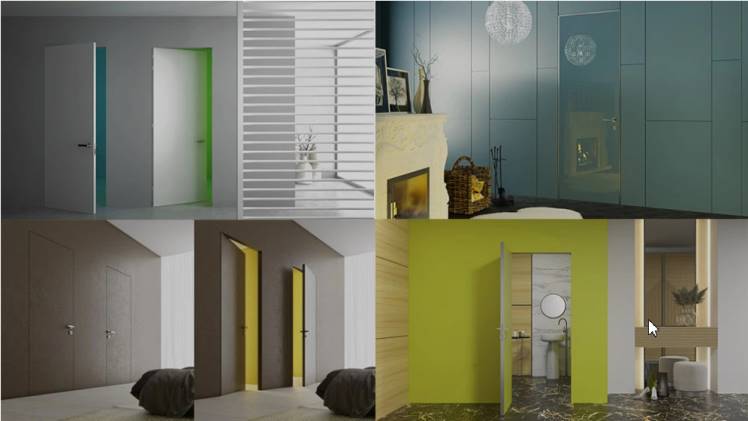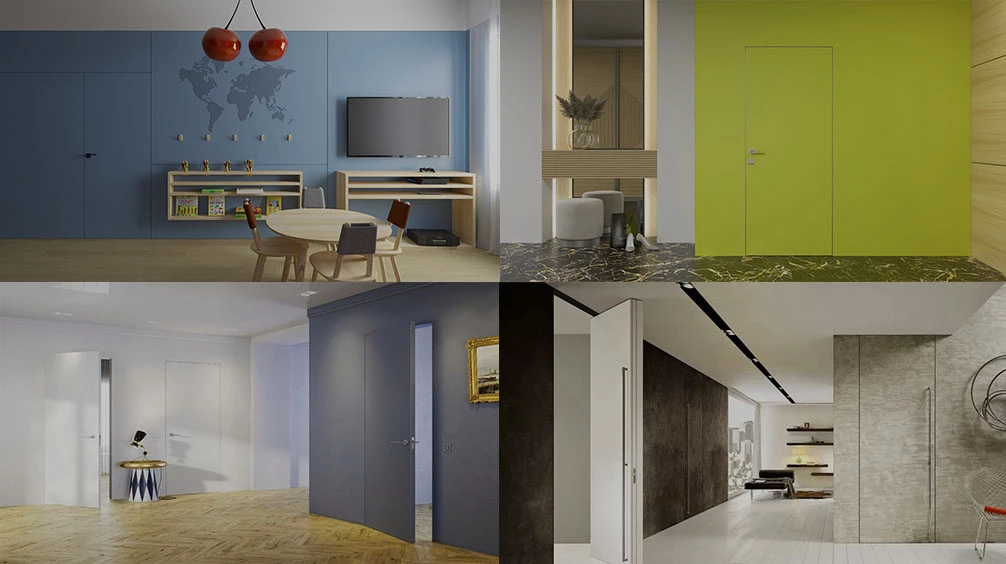All about Doors with Hidden Frames

Owners of apartments and houses often seek to create a unique interior while maintaining a light and harmonious atmosphere. One popular design solution that redefines the concept of a classic interior is invisible doors with hidden frames. Their special design allows the door panel to seamlessly blend with the surroundings, preserving the integrity and style of the space. They can visually enlarge the area, height, and width of the walls and are also used in creating concealed rooms.
Hidden installation doors are door structures that are challenging to distinguish against the background of the wall. Their presence may only be revealed by a small gap between the frame and the door leaf.
Another sign may be the use of standard door handles. Each door manufacturer offers invisible models with different types of openings, materials, and finishes.
Now that we have explored what hidden installation doors are, let’s consider their main features, the variety offered by manufacturers, as well as the advantages and disadvantages of these structures. In conclusion, we will examine the features of installing this type of door and possible difficulties.
FEATURES OF DOORS WITH HIDDEN FRAMES
Doors with hidden frames possess the following characteristics:
- Frame Installation without Casings: The frame is installed without the use of casings. It is simply spackled and aligned with the wall, resulting in a neat opening, making the entrance to the room practically invisible.
- Door Panel Material: The door panel is crafted from a special material that can be painted or covered with wallpaper to create a cohesive interior in the room. Hidden doors of this type are considered “finish-ready,” but door panels with standard factory finishes are also available at a comparable price.
- Hinge Integration: The door panel is secured in the frame with specially designed inset hinges. These hinges are concealed within the door frame and are nearly imperceptible when the doors are closed. Swinging mechanisms in pivot and rotary models may also be utilized.
- Inset Hardware for Hidden Doors: Inset hardware designed for hidden installation doors is a distinctive feature. Handles designed for sliding structures can be used for these doors as well. By carefully selecting concealed handles, they can be made practically unnoticeable against the door panel.

TYPES OF HIDDEN DOORS
Hidden door structures are classified based on several criteria. Depending on the finish on the panel, they can be of the following types:
- One-sided: Characterized by minimal thickness, this type is used when the entrance needs to be concealed only from one side.
- Two-sided: Can have any thickness, often matching the partition thickness into which the doors are inserted. Special materials are used in their manufacture, allowing them to be lightweight even with considerable thickness. The finish on the hidden doors may differ on each side, offering the option of a standard decor on one side and a custom design on the other.
The mechanism of hidden doors can also vary, leading to the following types:
- Swinging: This mechanism is commonly used, requiring a simple push on one side of the panel to open the doors. It’s a versatile model suitable for both apartments and offices.
- Pivoting: Opening in both directions, similar to the entrance doors in metro stations.
- Rotating: The door panel has a single axis of rotation located in the central part of the opening. When opened, the door rotates around its axis.
- Sliding or cassette-type: These panels slide along the wall or hide in a specially crafted niche when opened or closed. Doors of this hidden installation type significantly save space, making them a popular choice for smaller areas.
Hidden door panels vary in terms of finish types, offering a wide range of options from drywall to mirrors and decorative panels. Based on this parameter, invisible doors can be categorized as follows:
- Unfinished
This type serves as a blank canvas that can be decorated to blend seamlessly with the overall aesthetics of the room or snugly fit against the wall. Ideal for DIY decoration and camouflage, these models can be covered with wallpaper matching the wall tone or integrated into murals, creating a part of the room’s wall design, a standalone painting, or a photo. - Primed
These models are treated with a special moisture-resistant protection and coated with primer. The treated surface allows for painting with any type of paint and can be adorned with decorative plaster. - Painted
To make interior doors truly invisible, they can be painted to match the wall color. Manufacturers offer door panels painted in any color from the PAL or NCS catalog. Painting can be solid or multicolored, and it’s even possible to create landscape imitations or apply graffiti on the wall, completely concealing the entrance from prying eyes. - Veneered
The finish of hidden door panels can be done with natural veneer or eco-veneer. - Glass
Featuring tinted or satin-finished glass coatings, glass hidden doors add a touch of elegance. Mirrored doors in mirrored panels are especially striking. - HPL Coating
A durable and environmentally friendly coating with a wide variety of texture designs.
FROM WHICH MATERIAL IS A CAMOUFLAGED DOOR MADE?

Hidden door structures can be crafted from a variety of materials:
- PVC (Polyvinyl Chloride): This is the most cost-effective option. Its downside lies in its limited ability to camouflage. Even if the door panel undergoes meticulous processing, it may still remain too noticeable against the backdrop of walls.
- Aluminum: Concealing a door made of this metal is very lightweight and durable, but painting and treating an aluminum structure can be challenging, which is a drawback.
- Glass: These are practical and durable items. Their only drawback is transparency, which is undesirable for concealed constructions.
- Wood: This material is easily processed, but wooden doors are relatively heavy. An additional advantage of wooden products is good sound insulation and a high level of reliability.
- MDF (Medium-Density Fiberboard): Models made of solid wood can be quite expensive. To save costs, products made of MDF or particleboard are often chosen as they meet the criteria of cost-effectiveness and quality.
When choosing invisible doors, it’s also important to consider the material of the door frame. It can be made of aluminum profile or wood. The second option is rare. For heavy glass or wooden doors with concealed installation, an aluminum structure would be a more suitable choice, as it can easily support the door panel, even one of considerable weight.
TIPS FOR CHOOSING CONCEALED DOORS
To conclude this article, let’s explore the recommendations from experienced craftsmen on choosing doors with concealed installation. These tips will assist you in selecting a construction that seamlessly integrates into your interior.
- Pre-select the Material and Finish of the Room: Plan ahead by choosing the material and finish of the room so that the door panel can be coordinated accordingly.
- Purchase Doors Before Finishing Works: Buy the doors well in advance, even before the completion of finishing works in the space.
- Opt for Standard Door Sizes: Aim to choose door panels of standard sizes to avoid additional costs associated with non-standard dimensions.
- Accurately Measure Floor Covering Thickness: Precisely measure the thickness of the floor covering. This parameter is crucial both in selecting the door panel and during its installation.
- Decide on Door Opening Method and Side: Determine in advance the door opening method and the side of the opening. This is essential for correctly manufacturing the frame and mounting hinges on the required side.
- Purchase from Specialized Stores: Acquire concealed doors from specialized stores that provide warranties for the quality of their products.
- Professional Installation: Entrust the installation of these doors to professional craftsmen. Only in such cases will the installed construction perfectly blend into its surrounding design and not stand out against the walls.
By following these tips, you ensure that the chosen concealed door not only meets your functional requirements but also seamlessly enhances the overall aesthetics of your space.



